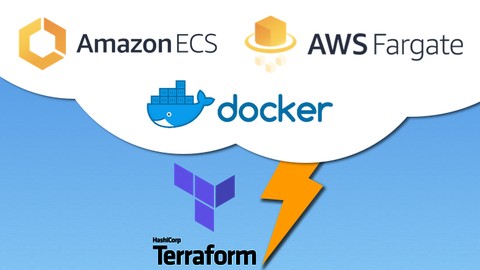
Deploy Fargate ECS Apps & Infrastructure: AWS with Terraform
Deploy Fargate ECS Apps & Infrastructure: AWS with Terraform, available at $59.99, has an average rating of 4.5, with 67 lectures, based on 693 reviews, and has 4103 subscribers.
You will learn about Learn how to work and code against AWS using Terraform! Learn how to work with AWS Fargate using Terraform! Implement ECS Fargate Applications on AWS using Terraform with Infrastructure-as-Code (IaC)! Learn how to register a domain with Route53 and use with Application Load Balancer for AWS ECS Fargate! Learn how to create an SSL HTTPS Certificate for your Route53 domain! Learn to implement 3-Layered Production-Grade Infrastructure for your Applications on AWS using Terraform IaC! You'll be confident to work with AWS using Terraform for any kind of AWS Resource on VPC and ECS Fargate! Learn how to Dockerize your Spring Boot Applications Learn how to create a Dockerfile for your application Learn how to create a Task Definition for your AWS ECS container application Learn how to develop end-to-end pipeline with Shell Scripting for application deployment! Learn how to read and code against an Terraform HCL language! You'll be able to launch your own infrastructure on AWS without even signing-in to AWS! Learn the AWS Well-Architected Framework Best-Practices while implementing! This course is ideal for individuals who are Who wants to learn AWS ECS Fargate; one of the best container environments out there! or Who wants to design and develop AWS ECS Fargate deployment from zero-to-hero using Terraform! or Who wants to learn how to implement Infrastructure-as-a-Code (IaaS) with Terraform on AWS or Who wants to learn Terraform, infrastructure configuration language from Terraform or Who wants to learn how to launch Virtual Private Clouds, Public-Private Subnets and more with Terraform code on AWS or Who wants to learn and launch Highly-Available, Scalable, Fault-Tolerant and Resilient architectures on AWS! or Beginners on AWS who wants to put their theory in practice It is particularly useful for Who wants to learn AWS ECS Fargate; one of the best container environments out there! or Who wants to design and develop AWS ECS Fargate deployment from zero-to-hero using Terraform! or Who wants to learn how to implement Infrastructure-as-a-Code (IaaS) with Terraform on AWS or Who wants to learn Terraform, infrastructure configuration language from Terraform or Who wants to learn how to launch Virtual Private Clouds, Public-Private Subnets and more with Terraform code on AWS or Who wants to learn and launch Highly-Available, Scalable, Fault-Tolerant and Resilient architectures on AWS! or Beginners on AWS who wants to put their theory in practice.
Enroll now: Deploy Fargate ECS Apps & Infrastructure: AWS with Terraform
Summary
Title: Deploy Fargate ECS Apps & Infrastructure: AWS with Terraform
Price: $59.99
Average Rating: 4.5
Number of Lectures: 67
Number of Published Lectures: 67
Number of Curriculum Items: 68
Number of Published Curriculum Objects: 68
Original Price: $69.99
Quality Status: approved
Status: Live
What You Will Learn
- Learn how to work and code against AWS using Terraform!
- Learn how to work with AWS Fargate using Terraform!
- Implement ECS Fargate Applications on AWS using Terraform with Infrastructure-as-Code (IaC)!
- Learn how to register a domain with Route53 and use with Application Load Balancer for AWS ECS Fargate!
- Learn how to create an SSL HTTPS Certificate for your Route53 domain!
- Learn to implement 3-Layered Production-Grade Infrastructure for your Applications on AWS using Terraform IaC!
- You'll be confident to work with AWS using Terraform for any kind of AWS Resource on VPC and ECS Fargate!
- Learn how to Dockerize your Spring Boot Applications
- Learn how to create a Dockerfile for your application
- Learn how to create a Task Definition for your AWS ECS container application
- Learn how to develop end-to-end pipeline with Shell Scripting for application deployment!
- Learn how to read and code against an Terraform HCL language!
- You'll be able to launch your own infrastructure on AWS without even signing-in to AWS!
- Learn the AWS Well-Architected Framework Best-Practices while implementing!
Who Should Attend
- Who wants to learn AWS ECS Fargate; one of the best container environments out there!
- Who wants to design and develop AWS ECS Fargate deployment from zero-to-hero using Terraform!
- Who wants to learn how to implement Infrastructure-as-a-Code (IaaS) with Terraform on AWS
- Who wants to learn Terraform, infrastructure configuration language from Terraform
- Who wants to learn how to launch Virtual Private Clouds, Public-Private Subnets and more with Terraform code on AWS
- Who wants to learn and launch Highly-Available, Scalable, Fault-Tolerant and Resilient architectures on AWS!
- Beginners on AWS who wants to put their theory in practice
Target Audiences
- Who wants to learn AWS ECS Fargate; one of the best container environments out there!
- Who wants to design and develop AWS ECS Fargate deployment from zero-to-hero using Terraform!
- Who wants to learn how to implement Infrastructure-as-a-Code (IaaS) with Terraform on AWS
- Who wants to learn Terraform, infrastructure configuration language from Terraform
- Who wants to learn how to launch Virtual Private Clouds, Public-Private Subnets and more with Terraform code on AWS
- Who wants to learn and launch Highly-Available, Scalable, Fault-Tolerant and Resilient architectures on AWS!
- Beginners on AWS who wants to put their theory in practice
Learn to implement production-ready infrastructure with AWS ECS Fargate container platform using Terraform today with an AWS Certified Solutions Architect!
Do you want to implement your complete infrastructure as code? Do you want to learn the coolest and most popular infrastructure configuration management tool on the market, Terraform and make a huge contribution to your skillset?
Then this course is what you need! You will not only learn how to implement Terraform code but also implement an AWS Well-Architected Framework recommended deployment model which will be Highly-Available, Scalable, Fault-Tolerant and Resilient!
-
In this course, we will start by exploring the tools we need throughout the course. Just to note here too, we will need an IDE with a proper Terraform plugin available. An AWS account is also necessary so I will show you how to get one if you do not already have it. Sure we will set up our environment variables for Terraform deployments and also configure our IDE to use Terraform efficiently by installing a Terraform Plugin which will highlight the syntax and auto-complete everything we intend to do.
-
In between all these, I will also give you a crash course on Terraform where you will gain all the information you need to implement this infrastructure!
-
Once we have everything set up, now is time to get our hands dirty and write some Terraform code to implement our cool, shiny architecture!
-
We will start off with implementing our remote state and obtaining a key pair which we will use to connect to the instances we will launch. Once we get these done, we will first create the Virtual Private Cloud (VPC) environment. To meet the demands of high-availability, we will spread our private and public subnets to three different availability zones inside a region. We will also create our Private and Public Route Tables to manage the routing between our resources inside VPC.
-
We’ll also make sure to attach an Internet Gateway (IGW)to our VPC to use with public subnets so the resources in those will be able to access and receive public internet traffic. Our private subnet also need some form of internet connection but not both ways; we want only internet access for outgoing connections from our resources in private subnets! To satisfy this requirement, we will launch and attach a NAT Gateway to our private route table.
-
Now is the time to develop our AWS ECS platform! To start with, we will first register ourselves a domain which we will use for our Spring Boot application. Then we will create an ECS cluster, Target Group, Application Load Balancer, HTTPS Listener and Certificate and IAM roles for ECS cluster to prepare for application deployment.
-
Next up is to check out the Spring Boot application that we will deploy to AWS ECS Fargate!We will take a quick look and start by implementing our ECS Fargate Task Definition. We will move on to create our IAM Role and Policy, ECS Service, Target Group, Listener Rule and CloudWatch Log Group to finish up with getting ready to deploy our application!
-
In the next chapter, we will script the whole pipeline of our application from building with Maven to pushing Docker image to AWS Elastic Container Registry (ECR) and then to deploying to AWS ECS Fargate! We will create ourselves a shell-script to implement everything as a different stage and develop the whole pipeline!
-
Once we’re satisfied with the pipeline, we’ll start executing our stages one by one! We’ll first build the code, build and push our Docker image to AWS ECR and finally we will deploy our Spring Boot application to AWS ECS Fargate to have it up and running with our registered domain!
There are much more to come in this course and I cannot wait for you to come and learn the best practices from an AWS Certified Solutions Architect!
Course Curriculum
Chapter 1: Introduction
Lecture 1: Introduction
Lecture 2: About This Course
Lecture 3: What We Will Build In This Course?
Lecture 4: What Do You Need For This Course?
Chapter 2: Preparing The Environment for Development
Lecture 1: Create an AWS Account If You Don't Already Have It!
Lecture 2: Logging into AWS Console and a Walkthrough
Chapter 3: Linux Environment Setup
Lecture 1: Installing Terraform and IntelliJ Plugin
Lecture 2: Installing Docker
Lecture 3: Installing AWS SDK (CLI)
Lecture 4: Preparing AWS Credentials for Environment
Chapter 4: Windows Environment Setup
Lecture 1: Installing Terraform and IntelliJ Plugin
Lecture 2: Installing Docker
Lecture 3: Installing AWS SDK (CLI)
Lecture 4: Preparing AWS Credentials for Environment
Chapter 5: MacOS Environment Setup
Lecture 1: Installing Terraform and IntelliJ Plugin
Lecture 2: Installing Docker
Lecture 3: Installing AWS SDK (CLI)
Lecture 4: Preparing AWS Credentials for Environment
Chapter 6: Terraform and Fargate 101
Lecture 1: Terraform 101
Lecture 2: Fargate Basics
Chapter 7: Virtual Private Cloud (VPC) Network Infrastructure with Terraform – Part 1
Lecture 1: Creating S3 Bucket for Terraform Remote State
Lecture 2: Creating Our Project
Lecture 3: Defining Our Remote State Configuration
Lecture 4: Creating a Virtual Private Cloud (VPC)
Lecture 5: Creating Public Subnets
Lecture 6: Creating Private Subnets
Chapter 8: Virtual Private Cloud (VPC) Network Infrastructure with Terraform – Part 2
Lecture 1: Creating a Route Table for Public Routes
Lecture 2: Creating a Route Table for Private Routes
Lecture 3: Associating Route Tables with Subnets
Lecture 4: Creating an Elastic IP for NAT Gateway
Lecture 5: Creating the NAT Gateway and Adding to Route Table
Lecture 6: Create an Internet Gateway (IGW) and Adding to Route Table
Lecture 7: Executing Terraform and Outputting Variables for Remote State Reading
Chapter 9: Elastic Container Service (ECS) Platform Infrastructure with Terraform
Lecture 1: Registering a Domain on Route53 for Our ECS Platform
Lecture 2: Defining Backend and Reading Remote State for Layer 1 Infrastructure
Lecture 3: Creating ECS Cluster
Lecture 4: Creating Application Load Balancer (ALB) with Security Group for ECS Cluster
Lecture 5: Creating HTTPS Domain SSL Certificate and Validating for ECS Cluster
Lecture 6: Adding Route53 Record for ALB Domain Name
Lecture 7: Creating a Default Target Group for ECS Cluster
Lecture 8: Creating an HTTPS ALB Listener for Load Balancer for ECS Cluster
Lecture 9: Creating IAM Role for ECS Cluster
Lecture 10: Attaching IAM Policy to ECS Cluster Role
Lecture 11: Executing Terraform and Outputting Variables for Remote State Reading
Chapter 10: ECS Fargate Application Deployment with Terraform
Lecture 1: Taking a Look at Spring Boot Application We Will Deploy
Lecture 2: Defining Backend and Reading Remote State for Layer 2 Infrastructure
Lecture 3: Creating ECS Task Definition
Lecture 4: Resolving Template and Creating ECS Task Definition
Lecture 5: Creating IAM Task and Execution Role and Policy for ECS Tasks
Lecture 6: Creating Security Group for ECS Service
Lecture 7: Creating ALB Target Group for ECS Service
Lecture 8: Creating ECS Service
Lecture 9: Creating ALB Listener Rule for ECS Service
Lecture 10: Creating CloudWatch Log Group for ECS Service
Lecture 11: Reviewing Our Code and Infrastructure Before Execution
Lecture 12: Providing Tfvars for Terraform Variables
Chapter 11: Scripting The Pipeline and Deployment of Fargate Spring Boot Application
Lecture 1: Creating a Dockerfile for Our Spring Boot Application
Lecture 2: Creating a Shell Script for Deployment
Lecture 3: Implementing Deployment Stages for Shell Script
Lecture 4: 1st Stage – Implementing Code Build Stage
Lecture 5: 2nd Stage – Implementing App Dockerizing and AWS ECR Push
Lecture 6: 3rd Stage – Implementing App Deployment to ECS Fargate with Terraform
Lecture 7: 1st Stage – Building the Code
Lecture 8: 2nd Stage – Dockerizing App and Pushing to AWS ECR
Lecture 9: 3rd Stage – Deploying App to ECS Fargate with Terraform
Lecture 10: Testing Out The Whole Architecture and Verifying Our Fargate App
Chapter 12: Wrapping Up
Lecture 1: Thank You!
Instructors
-
Niyazi Erdogan
AWS Certified Solutions Architect, Software Engineer
Rating Distribution
- 1 stars: 17 votes
- 2 stars: 21 votes
- 3 stars: 70 votes
- 4 stars: 272 votes
- 5 stars: 313 votes
Frequently Asked Questions
How long do I have access to the course materials?
You can view and review the lecture materials indefinitely, like an on-demand channel.
Can I take my courses with me wherever I go?
Definitely! If you have an internet connection, courses on Udemy are available on any device at any time. If you don’t have an internet connection, some instructors also let their students download course lectures. That’s up to the instructor though, so make sure you get on their good side!
You may also like
- Best Yoga Instruction Courses to Learn in March 2025
- Best Stress Management Courses to Learn in March 2025
- Best Mindfulness Meditation Courses to Learn in March 2025
- Best Life Coaching Courses to Learn in March 2025
- Best Career Development Courses to Learn in March 2025
- Best Relationship Building Courses to Learn in March 2025
- Best Parenting Skills Courses to Learn in March 2025
- Best Home Improvement Courses to Learn in March 2025
- Best Gardening Courses to Learn in March 2025
- Best Sewing And Knitting Courses to Learn in March 2025
- Best Interior Design Courses to Learn in March 2025
- Best Writing Courses Courses to Learn in March 2025
- Best Storytelling Courses to Learn in March 2025
- Best Creativity Workshops Courses to Learn in March 2025
- Best Resilience Training Courses to Learn in March 2025
- Best Emotional Intelligence Courses to Learn in March 2025
- Best Time Management Courses to Learn in March 2025
- Best Remote Work Strategies Courses to Learn in March 2025
- Best Freelancing Courses to Learn in March 2025
- Best E-commerce Strategies Courses to Learn in March 2025






















